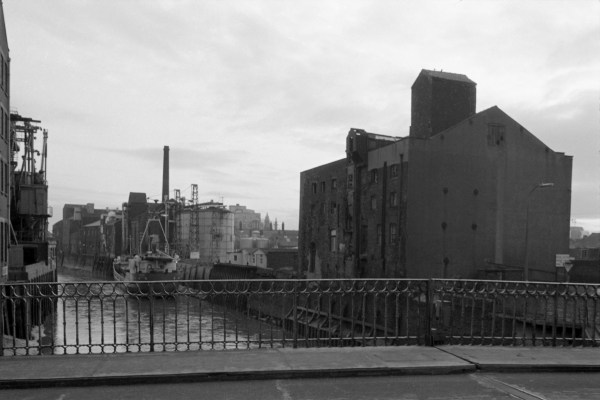
33g22: River Hull view downstream from Scott
St Bridge, 1982 - River Hull
Previous
Next
A view of Hull
Still Occupied
Images on this site are arranged into rough areas by location as in my book 'Still Occupied', available on Blurb. Eventually this site will contain all the images in that book and more.
One of Hull's Grade II listed buildings, Scott St Bridge, a hydraulically-powered double bascule bridge, was opened in 1901, and was 'temporarily closed' in November 1996. The operating machinery has since been removed - though the official listing in 1994 says it was renewed late C20 and calls the bridge 'complete and operable' which suggests that it has been deliberately allowed to deteriorate by the council.
An application was made for consent for partial demolition of this bridge in 2007, apparently to save the small annual maintenance cost of the bridge in its fixed upright condition. The cost of a full refurbishment to put it back into use was estimated at £3-5m, but some feel a rather cheaper solution could be engineered to allow pedestrian and cycle use. Some Hull Council members were extremely keen for it to be demolished, but plans were abandoned as it was thought unlikely that the necessary consent would be obtained from the Government Office.
There were surprisingly few objections to its demolition, with the Environment Agency, Hull Society, the Humber Archaeology Partnership and the 20th Century Society raising no objections. A 'historical audit' was carried out apparently concluding "the bridge should not be kept". Fortunately English Heritage, the Victorian Society and the Ancient Monuments Society stood firm. English Heritage because a council demolishing a listed building it owned would be a bad example and the AMS realising its "intrinsic and historical value".
As someone who has often had to detour on my walks, I find the conclusion that "there are alternative bridges crossing in the vicinity for pedestrians and cyclists as well as vehicles" unsatisfactory. It adds around 900 metres to a journey from Scott St to St Mark St via North bridge or around 1100m via Sculcoates Bridge. Obviously this was a statement made by those who only ever travel by car.
The whole story of this bridge - and of the failure to conserve other buildings in the area - is a part of the cultural snobbism that regards industry and the monuments of industry as of little or no value. Given the tremendous importance of this country in the industrial revolution and scientific and engineering advances of the nineteenth and 20th century this is ludicrous. It's a prejudice that English Heritage at least did a little (though not enough) to combat with its listing of structures such as this in the 1990s.
At the right of the picture is Grosvenor Mill and beyond that a ship is moored at a wharf - unfortunately the image is not sharp enough to read its name because of depth of field. All of the buildings visible on the bank beyond the mill are now demolished
Comments:
Andy Hazell: And the reason that the bridge does not function after having spending a huge amount putting new decking on the bridge is that the idiots in the council replaced the old hydraulic accumulator with very expensive new pumps which got contaminated with salt water as the bridge raising piston seals were not replaced. No one thought to replace the seals on the bridge which are actually immersed in salt water at high tide. Sad, stupid, and expensive...
Mike Covell: Scott Street bridge was not opened in 1901. The foundation stone was laid on Thursday October 3rd 1901, the bridge was opened by Alderman Jarman on Friday October 3rd 1902, the same day as his 60th birthday.
Peter Marshall
01784 456474